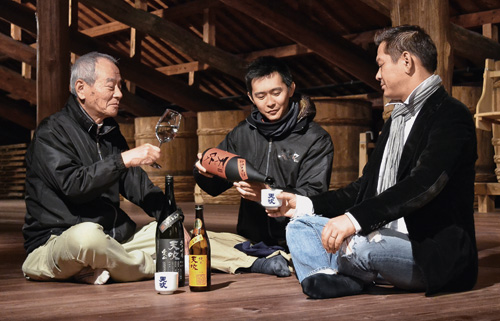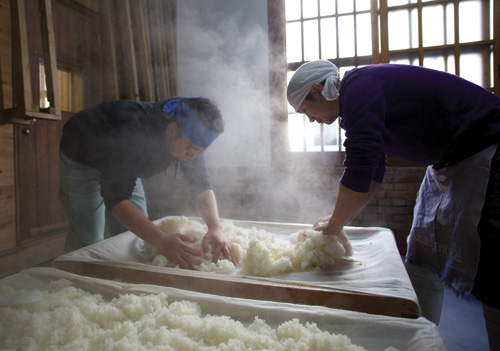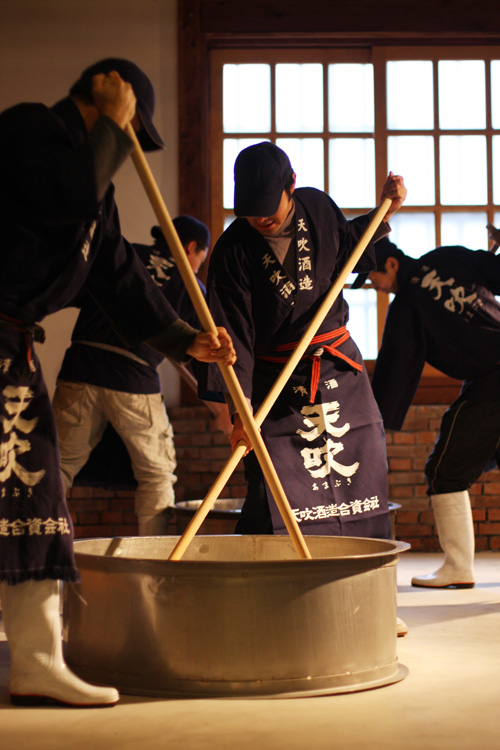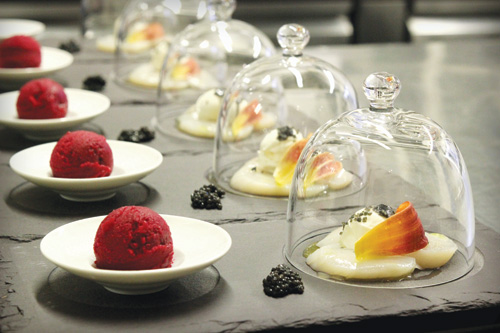A guide to premium Japanese sakes
Roger Jones, owner of the Harrow at Little Bedwyn, Wiltshire, breaks down the process behind the creation of premium Japanese sakes
Creamy banana, fresh green apple, soft sweet pears, stone fruit and perhaps honeyed sweet melon. These flavours usually describe wines, but did you know that they can also describe sake?
Sake is brewed just like beer but, due to its high alcohol content (around 15%) and its taste, is more comparable to wine.
For most people, sake is a hot liquid served in conveyor-belt sushi bars, made via bulk industrial production. But its image is being transformed in some enlightened restaurants. Here, premium sake is listed next to vintage Champagne and prestigious cuvées, and served with an eclectic mix of food styles from diverse cuisines.
What goes in
To produce fine sake, the grain must be polished. The higher the polishing, the better the quality.
A good polish
For high-quality sake, the rice is polished before processing to obtain the highest possible proportion of the starch, which is concentrated in the centre of the rice grain. The lower the rice polishing ratio, the finer and more aromatic the sake will be. Only 30% of sake is classified as premium.
There are six categories of premium sake: junmai daiginjo, junmai ginjo, junmai, daiginjo, ginjo and honjozo.
All sake in the junmai categories is brewed from polished rice and water only. Other premium sakes are allowed to add brewer's alcohol under 10% of rice weight. For non-premium sake, brewers can add more alcohol along with other ingredients like glutamate.
The water
As with Scotch whisky, water is an integral part of sake production. Sake breweries are often built near excellent water sources. Japan isa very wet country, and both mountain snow and forest rain are filtered by dense moss,giving natural, pure water.
Most water used in sake is relatively hard and high in phosphorus and magnesium, which is important for fermentation and producing a strong flavour and clear structure. Softer water is used for more delicate sakes, producing a milder and smoother style known as onna-sake (ladies' sake).
Virgin priestesses
Sake is brewed. Its production is reminiscent of beer production, except that where beer is brewed from malt, sake comes from rice. The heart of the production is the conversion of rice starch into sugar. With the first sakes more than 2,000 years ago, an enzyme in the saliva was responsible for achieving this - virgin priestesses chewed boiled rice, which then began to ferment.
In modern-day production, a koji mould is used to initiate the fermentation process. A fine powder of the koji fungus is added to rice that has been steamed, and a precisely controlled temperature brings about fermentation within a few days.
This fermented rice is then combined with freshly steamed rice and water, forming the first 'mash'. The entire production process is carried out at low temperature, which is why sake is traditionally brewed in winter, to take advantage of the natural coolness.
Toji
The brewer is called the toji and responsible for the production of the sake in much the same way as a winemaker. The summer months are spent tending the rice fields.
Storage and shelf life
After it has brewed, the sake is kept in steel tanks or bottles and aged for six to 12 months. Before storage and at bottling the sake is pasteurised for a few seconds at 62°C. Sake is sensitive to light and temperature fluctuations, just like wine is, so it is important that the best-quality sake is shipped in refrigerated containers or by air from Japan to Europe.
It is important to store sake in a fridge or a wine cellar. After it is opened, sake is fine for a few weeks in a fridge, and does not need pumping. Special sake glasses are available, but Riesling or Sauvignon blanc glasses work equally well. Sake is traditionally served slightly chilled, at between 10°C and 15°C.
Sake rice varieties
There are some 60 rice varieties used in sake, but here are the most popular:
Yamada Nishiki Grown in the south western regions of Hyogo and Hiroshima. This is the king of sake rice and the variety most commonly used in Japan's national annual sake competition. Sake made from this riceis fruity, lively and elegant.
Gohyakumangoku Grown in the northwestern regions of Niigata, Ishikawa and Toyama. Light, dry and very refined sake comes from this rice.
Omachi Grown in the southwestern regions of Okayama and Hiroshima. It gives delicate, dry and excellent acidity to the sake.
Miyama Nishiki Grown in the northern regions of Akita, Yamagata and Nagano. Gives a sake with diverse tastes and beautiful acidity.
Food and sake pairings
Restaurants around the world have started to realise the benefits and the diversification of sake to bolster their drinks offer. Here we list some possible food and sake matches. Remember: sake should be treated like a wine - it's not just an alcohol that goes with sushi or Japanese food, although an influence of Japan cuisine can help.
Fukuju, Awasaki Sparkling
A lively, dry, full-flavoured sparkling sake with a low alcohol level of 6%. Offers hints of cherry blossom that work well with canapés such as foie gras or with lemon tart.
Toko, Junmai
Classic-style sake with mild umami and good maturation. It has good intensity but a refreshingly clean aftertaste and can also be served warm. This one would be good with a more traditional Japanese-influenced dish such as sashimi of scallops - at the Harrow we serve it with beetroot sorbet and Exmoor caviar.
Katsuyama, En
This offers beautiful soft aromas of pear, banana and ripe peaches on the palate. It is full-flavoured, complex and multilayered, andit lingers. Katsuyama's En works well with seared yellow-fin tuna coated in curried spices with crème fraÁ®che.
Katsuyama, Lei
A very fine Pinot Gris-style sake with melon, pear and some vanilla influence. It would go well with simple chicken dishes or more fine-dining, such as English grey partridge. The balance of the sake is fantastic, and there's a lovely fruit sweetness that harmonises all the flavours.
Ikekame, Turtle Red
This sake is very forward on the fruit and rich, smooth and aromatic. Produced from the very rare black koji, Ikekame has a touch of Pinot Noir and would be good with robust fish dishes such as sea bass with truffles and morels.
Masuizumi, Junmai Daiginjo Special
This sake blew me away. It is vintage, aged in Burgundy oak barrels from Domaine Ramonet. It offers soft cloves on the nose, toasty aromatics and a lingering, luxurious taste with soft stone fruit. But it comes at a price - this sake is 17% alcohol and will set you back £360 wholesale, although it is worth every penny. Match with a lobster risotto.
Kirin, Vintage 2013, Junmai
A rich, full-flavoured sake with a sherry-like colour. Although it has had no oak, it goes darker with age. There is a touch of Riesling on the nose, then a delicate, very fine amontillado with dried apricots, honey, treacle and stem ginger. Try it with blue cheese.
Fukuju, Yuzu Sake
This is a combination of sake with the great yuzu fruit. It is a bright and stunning cordial-style drink (but 14%), which works ice-cold, chilled or with Champagne. A refreshing, rich and flavoursome drink.











